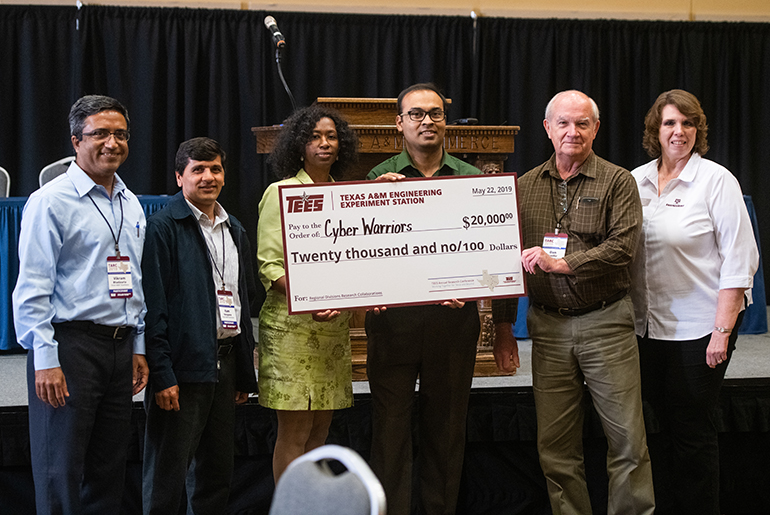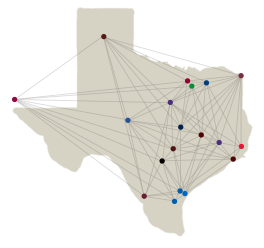At the 2019 Texas A&M Engineering Experiment Station (TEES) Annual Research Conference, researchers came together to create seven multi-institution collaborations and pitched them to a panel of judges at the end of the conference. TEES awarded $20,000 for the first place collaboration, $5,000 in seed funding to two second place collaborations, and $2,500 in seed funding to each of the additional collaborations.
$20,000 Award

Powering Up: Cybersecurity Education for a Dispersed Workforce
Team members: Abhijit Nag, Texas A&M-Central Texas; Camille Gibson, Prairie View A&M University; Daniel Creider, Texas A&M University-Commerce; Vikram Bhadauria and Ram Neupane, Texas A&M University-Texarkana; and Mirley Balasubramanya, Texas A&M University-San Antonio
The project addresses the need for effective cybersecurity education for a dispersed workforce that includes entry-level military personnel and aspiring law enforcement officers. Nag and a team of five others from Texas A&M Engineering Experiment Station regional division partners will create online instructional curriculum for a certificate program that will cover cybersecurity topics like artificial intelligence and provide lab simulations.
$5,000 Awards
Mapping Printed (3D) Scaffold for Goat Follicle Growth
Team members: Nabila Shamim, Prairie View A&M University; Lucy Huang, Texas A&M-Corpus Christi; and Ariful Bhuiyan, Texas Tech University
Ovarian cancer is the fifth leading cancer in women. The project’s goal is to create an engineering ovary that can restore fertility in women who suffer insufficient ovarian function due to ovary cancer treatment.
Remote Gas Detection System Using Fluorescent Nanoparticles
Team members: Maurizio Manzo, University of North Texas; Fawad Rauf and Mohammed Morsy, Texas A&M University-Texarkana
The team will develop a system to remotely detect and locate hydrocarbon gas leaks and seepage with high accuracy by using a unmanned aerial vehicle system equipped with GPS sensors, a camera and LEDs. Fluorescent nanoparticles will be sprayed so that leaks are detected by increased light intensity.
$2,500 Awards
Effect of Size, Shape and Atomic Ratio on Intensity of Fluorescence in Quantum Dots
Team members: Saravanan Ramasamy, Angelo State University, and Hye Jung Kang, Texas A&M-Texarkana
Quantum dots are bimetallic, light-emitting semiconductor nanoparticles that are used in bio-imaging, photovoltaics and LEDs. This project will identify ways to improve the quantum yield (brightness) of quantum dots by establishing a correlation between the atomic ratio in the quantum dots composition and the intensity of light emission. The goal is to provide a better signal in bio-imaging.
Electrification Infrastructure for Autonomous Vehicles
Team members: Marty Yaqub, Texas A&M University-Commerce; Deepak Ganta, Texas A&M International University; Huseyin Bostana, University of North Texas; Zahra Pournorouz, Tarleton State University; and Yuhao Xu, Prairie View A&M University
Currently there is no viable and affordable infrastructure to electrify autonomous vehicles. The team will explore a novel approach in converging emerging technologies in aesthetic PV shingles, lithium-ion energy storage, and 5G at strategic charging locations resulting in clean energy, clean air and the ability to travel long distances.
Innovative Approach for Using Artificial Intelligence Toward Sustainable Energy
Team members: Emmanuel Dada and Safuat H. Shakir, Prairie View A&M University; Patrick Carter and Sojung Kim, Texas A&M University-Commerce; and Manuel Garcia, Angelo State University
This team will develop a novel chemical process control approach using artificial intelligence –particularly agent-based simulation with machine learning to generate a cost-efficient control policy regarding crude oil distillation processes.
Social Perception of Green Infrastructure for Flood Erosion Control
Team members: Aldo P. Villarreal, Angelo State University; Dale Cope, Texas A&M University; Zhenhua Huang, University of North Texas; Perry Moler, Texas A&M University-Commerce; and Hua Zhang, Texas A&M University-Corpus Christi
Climate change results in more frequent flooding and erosion of earthen channels in underdeveloped storm infrastructure, but the use of green infrastructure may face public resistance. The team will model public perception and the use of green technology to reduce water erosion in San Angelo, Texas.


